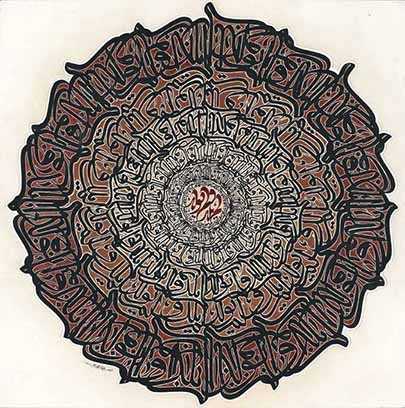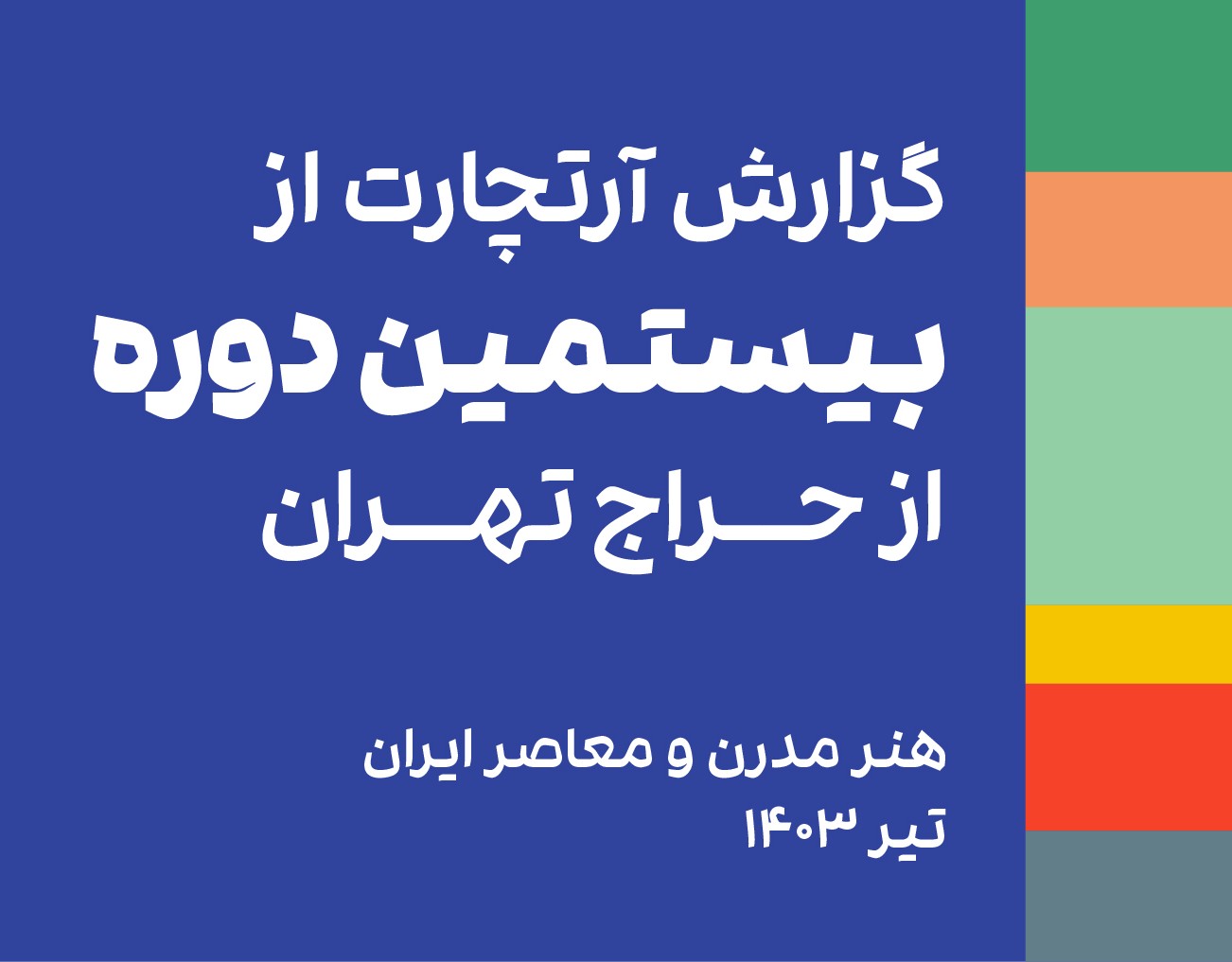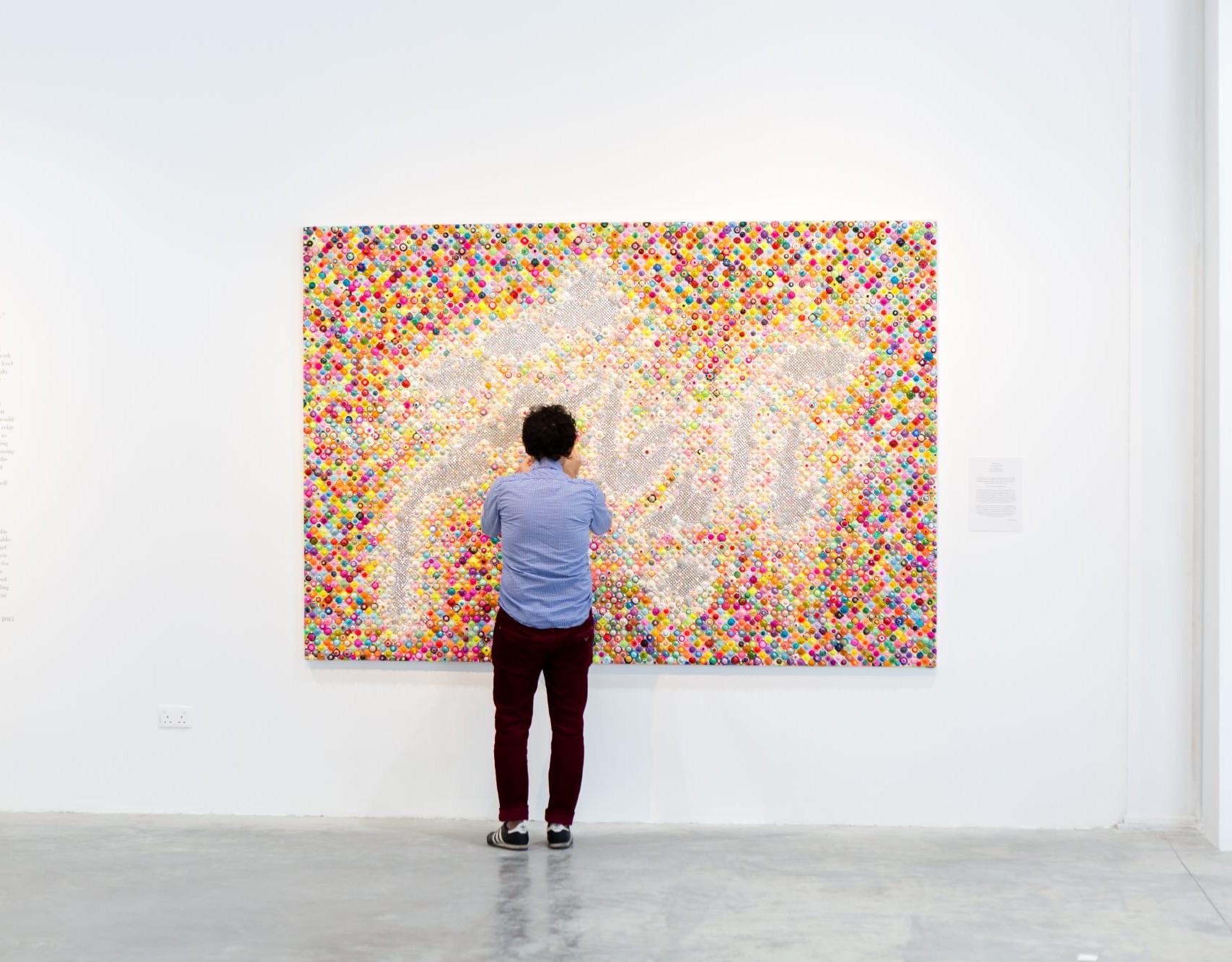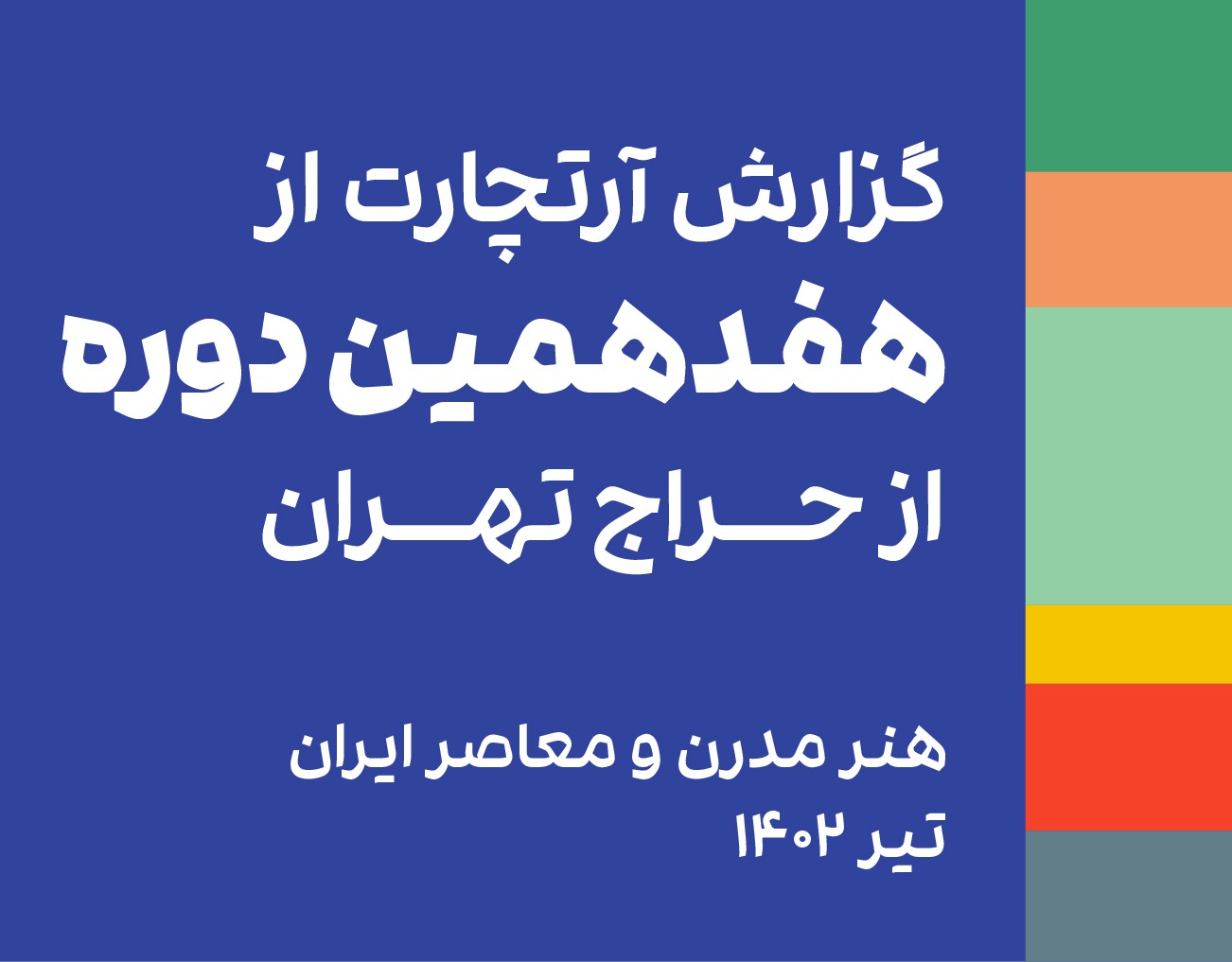About Nasrollah Afjei
Nasrollah Afjei was born in 1933 in Tehran. From a young age, he exhibited a strong interest and talent in calligraphy, painting, and music. At 15, he began his career in an atelier and, after a year, opened his own studio with a friend.
Upon completing his schooling, Afjei attended the Miniature Advertising Center, which he considered an art academy. Owned by Rassam Arabzadeh, this center allowed him to learn calligraphy from masters such as Kimia Ghalam Zanjani and Ali Akbar Kaveh. After finishing his military service in 1957, Afjei, along with friends Ali Akbar Sadeghi, Ali Reza, and Mahmoud Basiri, founded "Atelier Seven" on Baharestan Street in Tehran. This studio became a focal point for their artistic endeavors and attracted prominent artists including Morteza Momayez, Parviz Kalantari, and Abbas Kiarostami.
Afjei's work was first exhibited internationally in 1974 at the International Painting Exhibition in Switzerland. Over the years, his calligraphic paintings have been showcased in various countries, including France, England, the United States, and Germany. In 1993, he was awarded the first-class artistic award by the Ministry of Guidance and Islamic Culture. Additionally, Afjei has been actively involved in art education, teaching at the University of Tehran, Al-Zahra University, and Sooreh University.
During the 1960s and 70s, Afjei experimented with blending calligraphy and modern painting, influenced by neo-traditionalist art movements, particularly the Saqqa-khaneh movement. He presented these works in an exhibition titled "Calligraphic-Painting" at the Seyhoon Gallery. Afjei coined the term "Calligraphic-Painting," which later came to describe works combining painting and calligraphy.
In his calligraphic paintings, Afjei not only explored the potential of calligraphy but also integrated elements of the Iranian-Islamic tradition of calligraphy and page layout. Art critic Ruyin Pakbaz observed that "Afjei's expertise in various traditional calligraphy methods has diversified his calligraphic paintings. In the 1970s, Afjei created Op Art-inspired works using the Kufic-Bannai script and crafted deliberate compositions with Thuluth script features. Since the early 1970s, he has developed a more personalized style based on the Siyah mashq tradition, creating intricate combinations with hidden Nasta'liq intertwined letters."
Upon completing his schooling, Afjei attended the Miniature Advertising Center, which he considered an art academy. Owned by Rassam Arabzadeh, this center allowed him to learn calligraphy from masters such as Kimia Ghalam Zanjani and Ali Akbar Kaveh. After finishing his military service in 1957, Afjei, along with friends Ali Akbar Sadeghi, Ali Reza, and Mahmoud Basiri, founded "Atelier Seven" on Baharestan Street in Tehran. This studio became a focal point for their artistic endeavors and attracted prominent artists including Morteza Momayez, Parviz Kalantari, and Abbas Kiarostami.
Afjei's work was first exhibited internationally in 1974 at the International Painting Exhibition in Switzerland. Over the years, his calligraphic paintings have been showcased in various countries, including France, England, the United States, and Germany. In 1993, he was awarded the first-class artistic award by the Ministry of Guidance and Islamic Culture. Additionally, Afjei has been actively involved in art education, teaching at the University of Tehran, Al-Zahra University, and Sooreh University.
During the 1960s and 70s, Afjei experimented with blending calligraphy and modern painting, influenced by neo-traditionalist art movements, particularly the Saqqa-khaneh movement. He presented these works in an exhibition titled "Calligraphic-Painting" at the Seyhoon Gallery. Afjei coined the term "Calligraphic-Painting," which later came to describe works combining painting and calligraphy.
In his calligraphic paintings, Afjei not only explored the potential of calligraphy but also integrated elements of the Iranian-Islamic tradition of calligraphy and page layout. Art critic Ruyin Pakbaz observed that "Afjei's expertise in various traditional calligraphy methods has diversified his calligraphic paintings. In the 1970s, Afjei created Op Art-inspired works using the Kufic-Bannai script and crafted deliberate compositions with Thuluth script features. Since the early 1970s, he has developed a more personalized style based on the Siyah mashq tradition, creating intricate combinations with hidden Nasta'liq intertwined letters."
The Most Expensive Artwork
At Auctions
First Attendance
3 June 2008
# Attendance
81
# Artworks
103
Average Realized Price
58,183 USD
Average Min Estimate
41,740 USD
Average Max Estimate
57,825 USD
Sell-through Rate
80%
Average Growth of Artwork Worth
13.265%
Timeline
Artibition Auction - Dec 2025 auction
12 December
Artibition Auction - October 2025 auction
7 October
CHARSOO- Part 2 exhibition
3 October
The 24th Tehran - Contemporary Iranian Art auction
3 October
Charsoo exhibition
5 September
Artibition Auction - july 2025 auction
11 July
The 23rd Tehran - Modern and Contemporary Iranian Art auction
22 May
The 22nd Tehran - Modern, Classic and Traditional Iranian Art auction
14 February
Modern and Contemporary Collector exhibition
7 February
Treasure 6 exhibition
10 January
FINE FOLK OUTSIDER auction
18 November
Arthibition- November 2024 auction
25 October
The Pioneers of Modern Iranian Art Vol.3 exhibition
24 August
Resize exhibition
16 August
Darrous, 34 exhibition
2 August
The 20th Tehran- Modern and Contemporary Iranian Art auction
5 July
Golden Years exhibition
14 June
Artibition auction
7 June
Connoisseur's Look exhibition
19 April
+-50 exhibition
15 March
Artibition Auction - March 2024 auction
11 March
The 19th Tehran -Classic and Modern Iranian Art auction
24 January
Modern Collectore exhibition
19 January
Arthibition auction
20 October
Collector - Modern exhibition
29 September
The 17th Tehran Modern and Contemporary Iranian Art auction
18 July
Contemporary Art auction
4 May
resize exhibition
13 April
Collector exhibition
15 February
Contemporary Art II auction
1 December
Selected 6 exhibition
16 September
Lotfi x Mashahir Cross 2 exhibition
9 September
Art Closer Than Ever exhibition
26 August
Modern Collector exhibition
24 June
Connoisseurs Look exhibition
3 June
Group Exhibition Nasut and Nature 2 exhibition
13 May
Resize exhibition
13 May
5 Selected exhibition
22 April
Nowruz Festival of Rivers exhibition
10 March
The last event 1400 exhibition
25 February
Mirror reflections exhibition
19 January
The 15th Tehran- Modern Iranian Art auction
14 January
10th Collector exhibition
7 January
8th Collector exhibition
9 July
Small Artworks collection exhibition
11 June
The Collection of Liam Gallery exhibition
20 May
International Art auction
7 May
Modern and Contemporary Middle Eastern and North African Art auction
22 April
Gathered exhibition
22 March
Collector 7 exhibition
5 February
The 13th Tehran- Modern and Contemporary Iranian Art auction
15 January
No.8 auction
1 January
POST WAR & CONTEMPORARY ART auction
2 December
Middle Eastern, Modern and Contemporary Art auction
11 November
No.6 auction
16 October
Collector 6 exhibition
18 September
Calligraphy auction
16 July
Selected Artworks - Online Viewing Nasrollah Afjei exhibition
27 April
Frame 50 exhibition
21 February
دوازدهمین دوره حراج تهران auction
17 January
White Black Gray exhibition
13 December
Cama Chain exhibition
1 November
Middle Eastern, Modern and Contemporary Art auction
23 October
100 Works, 100 Artists Online Exhibition exhibition
2 August
یازدهمین دوره حراج تهران auction
5 July
دهمین دوره حراج تهران auction
11 January
The Color of the Sky exhibition
30 November
Middle Eastern, Modern and Contemporary Art auction
24 October
Manifestation Frame exhibition
28 September
The 9th Tehran- Classic and Modern Iranian Art auction
29 June
Modern and Contemporary Art of the Middle East auction
14 April
Dubai: Post War and Contemporary Art auction
22 March
Middle Eastern, Modern and Contemporary Art auction
25 October
Shams gallery Collection Special Sale exhibition
7 July
هفتمین دوره حراج تهران auction
7 July
Drouot Richelieu, Salle 5, Art Abstrait et Contemporain auction
9 June
Modern & Contemporary Art auction
18 March
Modern & Contemporary Art auction
18 October
پنجمین دوره حراج تهران auction
27 May
Modern & Contemporary Art auction
20 October
چهارمین دوره حراج تهران auction
29 May
Modern and Contemporary Arab, Iranian and Turkish Art auction
21 October
Contemporary Art auction
13 October
Islamic and Indian Art auction
7 October
سومین دوره حراج تهران auction
30 May
Islamic and Indian Art auction
8 April
Modern & Contemporary Arab, Iranian & Turkish Art auction
19 March
دومین دوره حراج تهران auction
28 May
Contemporary Art/Doha auction
22 April
Modern and Contemporary Arab,Iranian and Turkish Art Part II auction
17 April
Modern & Contemporary Arab, Iranian and Turkish Art Part I auction
23 October
1Ere Vente a Dubai International Modern And Contemporary Art auction
22 October
اولین دوره حراج تهران auction
22 May
Modern and Contemporary Arab, Iranian and Turkish Art Part I auction
17 April
Visions d'Orient - De l'orientalisme à l'art contemporain auction
4 November
Modern and Contemporary Arab, Iranian and Turkish Art Part II auction
26 October
Contemporary Art / Arab & Iranian auction
4 October
Modern and Contemporary Arab, Iranian and Turkish Art auction
19 April
Nasrollah Afjei solo exhibition exhibition
21 March
VENTE DE FEVRIER auction
12 February
Hurouf: The Art of the Word auction
16 December
Design, Art Contemporain, Photographie Contemporaine, Art Iranien auction
25 November
Tableaux Orientalistes et Art Moderne Arabe et Iranien auction
9 November
Contemporary Art / Arab & Iranian auction
20 October
Modern & Contemporary Middle Eastern & South Asian Art auction
11 October
Modern & Contemporary Middle Eastern & South Asian Art auction
2 June
International Modern & Contemporary Art auction
27 October
Art Moderne et Contemporain Iranien et Arabe auction
24 October
Contemporary Art Including Arab & Iranian Art auction
16 October
Modern & Contemporary Middle Eastern & South Asian Art auction
12 October
Tableaux Orientalistes et Art Moderne Arabe et Iranien auction
16 June
Modern & Contemporary Middle Eastern & South Asian Art auction
3 June
International Modern & Contemporary Art auction
29 April
Contemporary Art auction
18 March
INTERNATIONAL ART ORIENTALIST PAINTING auction
20 December
Tableaux Orientalistes et Art Moderne Arabe et Iranien auction
17 December
Modern & Contemporary Arab, Iranian, Indian & Pakistani Art auction
24 November
Modern and Contemporary Arab and Iranian Art auction
23 October
Tableaux Orientalistes et Art Moderne Arabe et Iranien auction
3 June
Articles
Report on the 20th Tehran Auction: The Seventh Auction of Modern and Contemporary Iranian Art 10 July 2024
The Tehran Auction commenced its operations by showcasing and selling modern and contemporary Iranian art, sustaining this focus for four consecutive sessions from 2012 to 2015. The 20th edition of the Tehran Auction, held on July 5, 2024, also centered on modern and contemporary Iranian art. During this session, 115 works by 111 artists were put up for auction, with 107 pieces succ...
Market of Iranian Neo-calligraphers 15 August 2023
Neo-calligraphic style entered the modern Iranian art movement in 1964 with the efforts of the pioneers of the Saqakhaneh movement, namely Hossein Zenderoodi, Parviz Tanavoli and Faramarz Pilaram. From this movement, later, a trend called Calligraphy-Painting branched out, which, to some extent, adhered to the rules and style of traditional calligraphy. Since the the 2000s, with the...
۱7th Tehran Auction Sales Report 26 July 2023
The 17th Tehran auction: modern and contemporary, was held on Friday July 21st, 2023 at Parsian Azadi Hotel. This auction achieved a total sale of 214 billion tomans equivalent to 4.3 million dollars, which was a growth of 77.8% compared to the previous period. Artchart has observed the 17th Tehran auction in the upcoming report.



